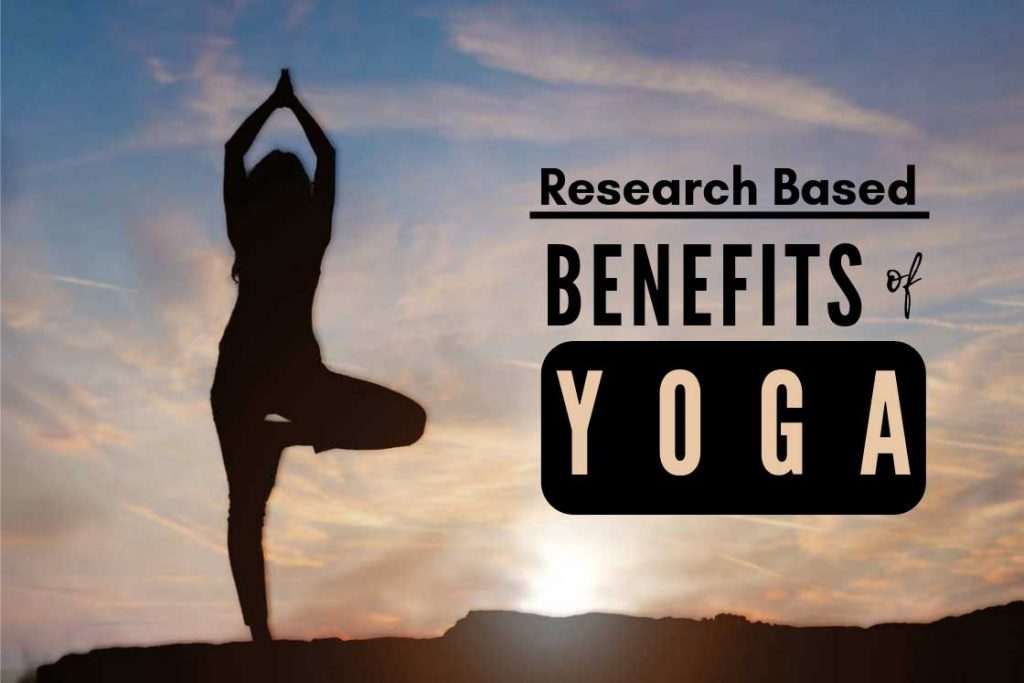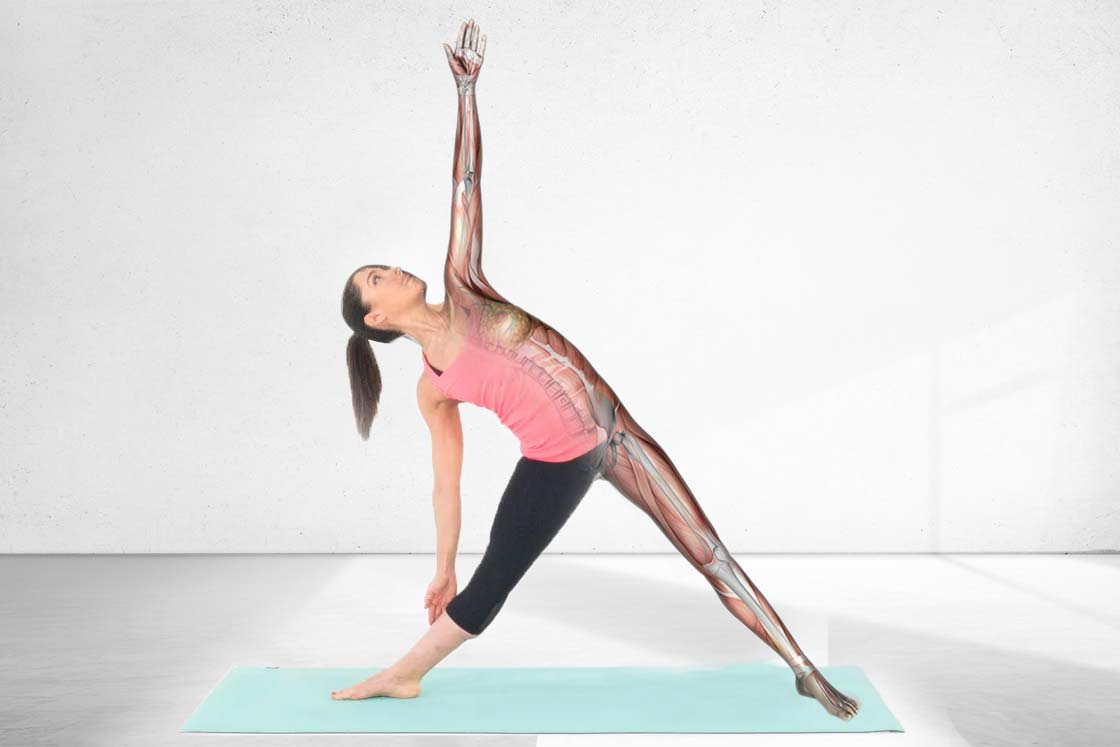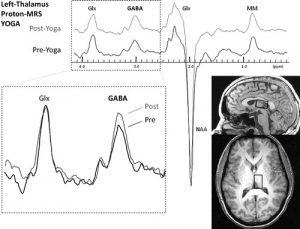
Many pieces of scientific research published in the past few years have proven the immense benefits of yoga on the mind & body.
In this article, being a doctor I covered the published scientific research based yoga benefits under a variety of categories. I have also covered some yoga practices which gives benefits in less than a month & helps you in flexibility, anxiety, depression, mental & physical health, decease prevention and building a better social status.
Before exploring the research-based yoga benefits, let’s see these Yoga Statistics which show the growing popularity of yoga.
Why does yoga become so popular ?
Because, In this hectic lifestyle, we all get so busy with our daily schedule & this is where we always forgot to take care of ourselves. Of course, taking care of our financial need is necessary, but what’s more important for us to take care of our body and mind as well. And this is where yoga comes into play.
Benefits of Yoga
When it comes to elaborating the benefits of yoga, they aren’t only certain hundreds of figures. Often, people think yoga is just for physical fitness and flexibility, but when they start to practice it, only then they realize yoga more profound benefits.
In favour of this fact, research has done.
Research has shown, the primary aim of 85% of yoga teachers was just physical fitness, but later on, they realize yoga has changed their behaviour, thinking, & mentality completely. Now they feel more flexible, calm, energetic and into the spiritual aspect of yoga & their primary aim becomes spirituality or the self-actualization.
Read on further to know the yoga benefits (physical, mental, and spiritual) based on many published pieces of research.
Physical Benefits of Yoga

We basically know Yoga for its beautiful postures and their physical benefits. Physical benefits are those which you can see in a person who practices yoga regularly. It can be a flexible body, a better balance & the charm on the face, etc.
1. Yoga Helps in Weight Loss
Hectic lifestyle & irregular diet plans have made obesity a problem in general. Systematic dietary guidelines & regular Yoga practice can help you manage the weight-related problems (whether its weight loss or gaining weight).
A research conducted on 17 enrolled participants for 3 months. In this research, participants were asked to follow up semi-standardized dietary guidelines along with the practice of therapeutic yoga classes 3 times a week.
Participants, on average, have lost 3.5 kg of weight. On maintaining the same diet and yoga practice in the next 3 months, participants further reduced an average of 5.6 to 5.9 kg weight.
Yoga breathing techniques are also a great way to burn belly fat.
2. Prevents Premature Ageing
Ageing is a natural process that brings changes in the dynamics of an individual characterized by a decrease in physical and mental capacity. Greying hair, wrinkled and atrophic skin, and the growing risk of diseases are the common symptoms of ageing.
Yoga is a natural and marvellous anti-ageing therapy that saves you from the side effects of cosmetics and chemical products that claim to delay ageing.
Yoga has proven effective in terms of improving the blood circulation and removal of toxins from the body, maintaining the youthfulness of face with glowing skin and thus preventing premature ageing.
As yoga strengthens the body, it increases bone density, the flexibility of muscles, and enhances mindfulness; therefore, it prevents the physical and mental draining. By stimulation of nerves, it also improves the vision and helps in eradication of several diseases.
A research has conducted to see the effects of Yoga and Meditation based lifestyle intervention (YMLI) on cellular ageing. It has shown in this study that, yoga increased cardinal and metabotropic biomarkers of cellular ageing and longevity in a healthy population.
Adopting Yoga and Meditation as a habit, chronologically, we can make ageing graceful with the prevention of complicated multifactorial lifestyle.
3. Maintain Strong Spine
The spine supports our central nervous system (CNS), which controls every cell of the body. It is the backbone protecting the spinal cord, providing structural support, and maintaining the correct posture of the body to enable flexible motion.
There are many yoga poses, out of which some are specific for the spine. These poses emphasize cultivating awareness around the spine and also giving it space to expand further.
Poses for Stroger Spine – Tadasana, Ardha Uttarasana, Chair Bharadvajasana, Supta Pavanamuktasana, Savasana, etc.
The main finding of a systematic review suggests that the practice of yoga can increase functional ability in patients with spinal pain and decrease pain.
4. Brings Flexibility in Muscles

Because of a sluggish and sedentary lifestyle, our body can get lazy and dehydrate itself, which makes tissue less supple and more prone to injury. Muscles become atrophic and stiff. The joints settle into a limited range of movement.
Yoga postures release tension from the body and mind. Stretching of the muscle and holding it in a specific yoga posture helps to strengthen the muscle fibres and increase its resilience.
In a pilot study 9 healthy young females were recruited and, included in therapeutic yoga exercises. It aimed at increasing joint mobility and stretching shortened skeletal muscles. Each training session comprised 10 minutes of pranayama, 10 minutes of warm-up exercises, 45 minutes of asana practice, and 10 minutes of relaxation.
The result has shown that the regular practice of Hatha Yoga improves muscle strength, increases joint mobility, and soft tissue flexibility. It also mobilizes the nervous system, improves body posture, and encourages better awareness of the body.
5. Improves Sleep Quality
Insufficient sleep can cause weight gain, fatigue, and depression-related problems. Insomnia (a sleep disorder) is becoming a mass problem all around the world.
Only in India, 93% of people are suffering from some sleep-disorders and out of these only, 2% know about it or consult the physician.
Yoga is excellent for reducing ‘arousal (which causes insomnia)’ using the practice of meditation & relaxation postures.
In a 10 week research done on chronic insomnia patients, they were asked to maintain sleep-wake diary & practice yoga meditation session by their own.
At the end of 10 weeks, it saw a significant improvement in SE (sleep efficiency), TST (Total sleep time), TWT (Total wake time) & SOL (Sleep onset latency) as measured from a sleep-wake diary
6. Yoga Enhance Hair Growth
Hair loss is one concern, which if involves at a young age group, causes emotional trauma. It has various etiology.
Stress induces hormonal changes because of pregnancy, thyroid disturbances, or even taking oral contraceptives responsible for hair loss. Physical stress, work pressure, improper diet, and reduced blood flow to the scalp also lead to compromised hair health. Therefore, modality to reduce hair loss and regrowth of the hair needs to be focused upon.
If we combine Yoga with other tension-reducing techniques, including scalp massage, it can benefit hair growth. Increase in blood flow to scalp improves the nutrient delivery and contributes to the growth of hair.
A paper published in the Journal of Harmonised Research in Applied Sciences states:
The practice of hatha yoga helps to overcome hair fall, and massage using herbal nutrients increases hair growth.
7. Improves Sexual Function
Yoga postures strengthen the core, which helps to have more control over the pelvis. It also works out as Kegel exercises (for pelvic floor) and enhances the erection. Yoga also increases the level of testosterone and enhances libido (sex desires).
According to a study published in The Journal of Sexual Medicine, regular yoga practice improves several aspects of sexual function in women. It includes desire, arousal, orgasm, and overall satisfaction.
Hence, Yoga proves to be a non-pharmacological method of improving sexual function.
8. Helps Women During Pregnancy & Menstrual Cycle
Physical activity in the form of yoga during pregnancy & periods has suggested in building a sense of confidence and competence in women.
In a pilot study, 16 pregnant women took part in low-intensity physical yoga throughout the pregnancy period. Their living conditions & physical efficiency over time was evaluated.
The report said women who took part in parental yoga, have a better effect on living conditions, self-efficiency for physical activity & prenatal care.
9. Yoga Breathing Techniques Glows the Skin
Yogic breathing also called Pranayama, purifies the blood and increases the supply of oxygen, which leads to glowing skin.
Yoga breathing techniques Kapalbhati, Anulom Vilom, Bhastrika, Bhramari,etc. accentuate the effect of asanas and help to solve skin woes by having anti-oxidant, cellular, and tissue effects for detoxification.
A review article explains various benefits of Pranayama, including its ability to make the skin healthy.
10. Strengthens The Bones
Bones health depend on the mineral content with calcium and vitamin D, which plays a significant role.
Yoga can stimulate the capacity of the bones to retain it. Weight-bearing poses like arm balances, inversions, and standing poses helps in bone deposition, remodelling, and also the reversal of bone loss.
In a 10-year study (2005-2015) 741 volunteers were recruited via the internet. The primary aim was to assess the effectiveness of selected yoga postures in raising Bone Mineral Density (BMD).
This study suggested improved bones quality among the participated volunteers with the reversal of bone loss in the spine and femur. It also increases BMD in the spine using yoga postures.
Internal organs system in the body plays a vital role in the overall health of a person. Every twist, bend, relax, and stretch in yoga asana affects the functioning of internal organs.
11. Strengthens Immune System
The immune system is the defense mechanism of our body. It comprises a network of cells and organs against foreign elements, e.g. bacteria, viruses, fungi, and other organisms.
Directly linked common infections like cold and flu, allergies, asthma, and other chronic respiratory conditions lead to a weakened immune response.
Breathing patterns in yoga (Pranayama) can increase the resistance of our respiratory tract from regulating ‘Prana.’
A study was conducted on 190 volunteers in the age group of 20 to 60 years. They practiced yoga regularly for over five years for one hour daily. Also, they performed moderate exercise and a bout of strenuous exercise. The non-yoga group also showed similar exercises, suggesting that regular practice of yoga reduces the resting levels of inflammatory cytokines like TNF-α and IL-6.
Yoga increases natural killer cells and rejuvenates immune organs and channels.
Various poses of yoga boost our Immune System by affecting different glands. Kurmasana (tortoise pose) has a positive effect on the thymus gland.
AdhoMukhaSvanasana (downward-facing Dog Pose) increases the flow of sinuses & Ustrasana (Camel Pose) lung mobility, which ultimately increases Immune System.
12. Increases Oxygen Intake
Breathing is one of the most important physiological processes which involves air movement in and out of the lungs. Breathing is possible only through Prana.
Because of improper breathing, oxygen intake becomes less in the lungs.
The exchange of oxygen and carbon dioxide takes place in the lungs. Inhaled oxygen moves from the lung’s alveoli to blood in the capillaries and carbon dioxide from the blood to the air in alveoli.
The intake of oxygen can be increased, and its consumption can be decreased with the consistent practice of yogic breathing (Pranayama). It increases the flow of oxygen, and various bending postures of yoga help to improve the pulmonary function.
A study was done to assess the effects of pranayama on the pulmonary function. It shows that pranayama is beneficial in improving lung ventilation and strength of respiratory muscles.
13. Boost Blood Circulation

Blood circulation is the process through which heart pumps a person’s blood around their body. It’s responsible for delivering nutrients and oxygen to all cells in the body.
Sedentary lifestyle, high cholesterol, irregular blood pressure & sitting all day at a desk leads to poor circulation. This poor circulation affects health and can also cause fluid retention and swelling in the body.
Physical movements of yoga postures compress and decompress the veins. Different poses, for example, Warrior pose, Headstands, Shoulder stand, Bow pose, Downward dog and deep breathing like Kapalbhati not only improves the flow of oxygen-rich blood but cardiac rehabilitation too.
An article of a systematic review found out that yoga is beneficial in improving cardio-metabolic health, boosts circulation and becomes an aid for good health.
14. Better Heart Health
Heart Beats about 115,000 times each day, and it comes around 60-100 beats per minute. You can imagine from these figures how consistently heart works.
Stress in heart functioning can lead to a heart attack, B.P, Cholesterol & Diabetes.
According to a fact published by Centre for Disease Control & Prevention (CDC) – 610,000 people in the US die cause of heart diseases every year (i.e. 1 in every 4 death).
According to the World Health Organisation (WHO), cardiovascular diseases are the number 1 cause of death globally.
Various studies suggested that Yoga can affect heart functioning across the healthy and pathological population. Via neurological pathways, yoga brings changes in the operation of the heart.
Yoga is capable of modifying the heart rate, blood pressure, improve lipid profile, and reduce BMI which all have their impact on the cardiovascular system.
A review article states that Yoga has not only been helpful in cardiac diseases but also has proven its significance in cardiac rehabilitation after heart surgeries.
15. Yoga Increases Metabolism
Metabolism is a natural functioning of the body which comprises chemical reactions that maintain life.
People having fast metabolism burn more calories during activity and even at rest as compared to people having a slow metabolism. On the other hand, slow metabolism tends to burn fewer calories, and people often eat less to avoid weight gain. Well, in both cases, individuals find it unfair to either be lean or obese.
Therefore, balanced metabolism is a bridge to lead a healthy life.
Yoga helps burn fats and influences metabolism directly. Various asanas have proven to be helpful in weight loss, stimulation of endocrine glands, and increasing one’s metabolism.
A study shows that yoga practice over time, combined with asana, pranayama, and meditation reduces the BMR.
Therefore, Yoga is a holistic practice to balance metabolism depending on the need of an individual.
16. Lowers Blood Pressure
High blood pressure (H.B.P) or hypertension is when blood in arteries exerts much pressure than the standardized value (140/90mm/hg).
H.B.P is also called the ‘Silent Killer’ as in the early stage, and it becomes very difficult to detect its symptoms. Furthermore, it affects the function of the heart & circulatory system by lowering oxygen content in the blood.
A study shows that adopting some particular Pranayama & Meditation techniques of yoga has reduced 10 mmHg systolic blood pressure & 8 mmHg diastolic blood pressure.
Indeed, yoga practices increase GABA activity. This increase in GABA further counteracts the muscles contraction activity of the Sympathetic nervous system.
Once muscles of the body come in relax condition (dominated Parasympathetic nervous system), blood arteries get space to expand. In this way, diastolic blood pressure decreased in the blood vessels.
Another research suggests that practicing yoga without physical postures is more effective in lowering short-term systolic blood pressure.
17. Increases Pain Tolerance
Pain is a subjective perception influenced by any noxious stimuli. It can be physical, emotional, and mental as in case of injuries.
Yoga increases the tolerance to resist the pain by producing neuroanatomical changes in the brain, changes structural grey matter and increased intra-insular connectivity.
Yoga Nidra reduces pain by stimulating Pituitary gland.
Yoga implements cognitive strategies like the detached observation of the present moment, controlling immediate reactions and increases acceptance, mindfulness, and relaxation. Therefore, yoga alters pain perception and increases the pain threshold.
18. Balance Hormone Secretion
Hormonal imbalance is a common phenomenon that impacts a person’s mood, behavior, habits, and overall health, including extra stress on the body. This stress is more common among females.
Imbalance in thyroid hormone can lead to insulin-dependent diabetes and various other endocrine-related disorders. It deteriorates the life condition of an individual.
Studies have confirmed that practicing certain postures compresses the abdomen & helps in stimulating the pancreatic hormone secretions. It further helps in avoiding diabetes. Some poses for pancreatic hormone secretions are half-twist pose combined with bow pose, half-spinal twist, and plow pose.
Yoga is a robust endocrine therapy. It is also concerned with 7 Chakras and Glands. Each chakra is thought to correspond with a particular nerve plexus and endocrine gland resulting in balanced hormonal secretion.
19. Balance Pulse Rate
Tachycardia is a condition in which the heart beats faster than normal or arrhythmical, and pulse rate recorded over 100 beats per minute.
Yoga can be a promising tool to lower the pulse rate.
A study has shown that yoga practitioners with an average of 16 months’ experience can drop the pulse rate.
Practitioners could effectively reduce their heart rates to 19.6 beats per minute when using yogic strategies. Alongside this, they could achieve a reduction of 22.2 beats per minute when using pranayama as a strategy for heart rate reduction.
In a research, 50 participants performed one hour of daily yoga for six months. After that, the group’s average heart rate had dropped from 77.8 beats per minute to 71.3 with the improved heart function.
20. Yoga Lowers Blood Sugar Level
A hormone secreted from the pancreas regulates the level of glucose in the blood. This hormone is Insulin.
In Type 1 diabetes, the pancreas doesn’t secrete insulin properly, and in Type 2 there is insulin resistance.
Diabetes Mellitus (DM) is the condition when the blood sugar level of an individual becomes high. Its also termed as hyperglycemia.
In both cases of diabetes (Type 1 & Type 2), the adverse effect because of increased blood sugar has seen, which are, e.g. fatigue, headache, excessive thirst and hunger, frequent urination, hypertension, blurred vision, etc.
Yoga has positive effects on endocrine glands and its cognitive approach to reduce stress and anxiety helps to regulate this mechanism.
To assess the beneficial effects of yoga on blood sugar levels in normal and Type 2 DM volunteers, research conducted & demonstrated a significant decrease in Fasting Blood Sugar and Post Prandial Blood Sugar level.
It has attributed the beneficial effect of yoga in Type 2 DM in terms of increased insulin sensitivity at target tissues. Increased insulin decreases its resistance and consequently increases peripheral utilization of glucose.
It has also been postulated that yoga can rejuvenate or regenerate beta cells of the pancreas. A review article states there was a significant fall in blood sugar values within three months of Yoga interventions among Type 1 DM patients. It also marked a significant reduction in drug requirements.
Mental Benefits of Yoga

In ancient time, Yogis supposed the evolution of yoga to eliminate the random thought patterns of the mind. Yoga is primarily the practice of mind-controlling.
You can feel the following mentioned below the emotional and mental benefits of yoga.
21. Yoga Uplifts The Mood

GABA or Gamma-Aminobutyric Acid is a neurotransmitter that helps calm the brain and reduce anxiety. Reduction in GABA levels is the main reason behind mood swings and anxiety disorders.
A study conducted by Boston University showed that yoga reduces stress and improves the mood by boosting the production of GABA.
According to the outcomes of this study : “The 12-week yoga interference has shown larger improvements in mood and anxiety than a metabolically harmonized walking exercise”.
It indicates that yoga uplifts the mood and makes a person feel euphoric.
22. Stress Buster
Stress manifests itself in many forms like mental, physical, and emotional. I especially find Yoga to be useful in handling stress.
According to recent research : Yoga is an easily available alternative method for stress relief because it lowers the cortisol (stress hormone) production and increases the production of endorphins.
Endorphins are hormones known to be natural pain and stress fighters. They act as drugs like morphine and codeine and help you relax.
Another study shows that yoga produces similar outcomes in minimizing stress as cognitive behaviour therapy.
23. Brings Positivity
Positivity in life can get you through even the toughest of moments. Another well-known fact is that positive emotions make you feel healthy and also reduces the chances of falling ill. In this regard, yoga fosters emotional vitality, positivity, and self-regulation.
Yoga does not exercise for just building muscles and reducing weight. It is a practice that offers psychological well-being, as well.
A week-long yoga camp study in an urban setting shows that:
Yoga reduced the negative emotions and increased positive feelings in regular healthy volunteers.
24. Calms The Mind

In yoga, there is a lot of emphasis on breathing control and meditation. These two things help you forget about all your troubles and just live at the moment. However, to validate this point, an experiment was conducted.
The remarkable discoveries of this investigation were
- Yogic breathing was established to be an excellent method for harmonizing the autonomic nervous system.
- It helped shift the balance from the sympathetic nervous system (related to stress and anxiety) to the parasympathetic nervous system (associated with calming the body).
25. Reduces Negative Emotions & Increases Happiness
This follows on the heels of the point mentioned above that yoga brings positivity in life and attitude. Because yoga minimizes the cortisol levels, the negative emotions too diminish in their intensity.
Practicing yoga consistently & regularly boosts the production of Serotonin (happiness hormone) in the body.
A cross-sectional comparative study was conducted on 50 subjects. The hypothesis that meditation increased positive thinking & thus increases happiness, had been tested in this study.
The study concluded that the mean happiness score of the meditators was considerably more significant than those of the non-meditators.
Yoga also has proven an efficient practice at the workplace, published in an article on Forbes. In this article, it’s shown how yoga programs boost the mental health of employees which certainly helps them in achieving career goals, reducing stress and hence increases overall happiness.
26. Makes Emotionally Strong
Look at the soldiers; they are emotionally strong not because they were born that way, but because they were taught emotional resilience from the very commencement of their training. Grit and determination make you ready to face any challenge that life throws in your way.
Yoga instills emotional well-being and fosters better tolerance to stress and anxiety. Therefore, it helps build our level of resilience.
A randomized controlled trial [efn_note] The effectiveness of yoga for resilience to stress in the workplace sjweh.fi[/efn_note] was conducted at a British University to test the emotional resilience of 48 employees. The conclusion drawn at the end of the study was that yoga is highly effective in enhancing psychological well-being, and it also made the employees emotionally healthy to handle stress.
27. Boosts Confidence
Having confidence depends on how well you can or cannot do something. Another aspect of being confident is to understand your body in its entirety (i.e., mind, body, and soul) and knowing its limitations.
Since yoga is known to teach its disciples to be entirely in tune with their body, it makes them more self-assured. But this is not just a plain stated fact.
In a bid to study the true effects of yoga on psychological well-being, multiple types of research were piloted.
It was found that yoga improved confidence levels by enhancing the physical and mental state of the body. Coming to terms with your body image and having greater control over your emotions gives a power thrust to confidence or self-esteem.
Working of Yoga on Brain Performance
The brain is an essential part of the body. Yoga works on better functioning and improves the overall efficiency of the brain. These experimental studies prove the working of yoga on brain performance.
28. Increases Gray Matter
Gray matter is that area of the brain, which is integrally associated with muscle control and sensory perceptions. It plays a vital role in seeing, hearing, memory, speech, decision-making, etc.

A study pointed out that long term yoga practitioners had more gray matter volume in the brain as compared to those who did not do yoga. It was also found that the volume of the gray matter was directly proportional to how long a person had been doing yoga.
So the more you do yoga, the higher is the gray matter volume and vice-versa.
29. Improves Concentration
Success can be measured by the efforts you put in to achieve your goals and how attentively you do. Yoga claims to improve the attention span of those who practice it regularly. It teaches the participants how to channel their energies in the right direction and makes the mind more determined.
A study of 69 male volunteers between the ages of 18 to 48 indicated significant improvement in their concentration and visual-spatial perusing abilities.
30. Boosts Memory

Retention of what you have learned is very important. This is where memory comes into play. But everybody does not have the same memory retention powers. However, yoga claims to boost memory. This claim is not without proof.
A review was completed at the school level to discover the evidence of yoga-based interventions on educational, cognitive, and psychosocial advantages. Memory assessment tools were used to figure out how yoga impacted memory.
The results showed increased memory performance for the group that practiced yoga.
31. Quick Reaction Time
Reaction time is all about how fast your mind processes the external simulators and takes appropriate action. Hand and eye coordination, brain and eye coordination, etc. determine the quality of performance. Therefore, it becomes necessary to be quick and mentally sharp.
In an experiment on 25 healthy male individuals, between the ages of 18 to 25 years, it was found –
“The Auditory Reaction Time (ART), the Visual Reaction Time (VRT), and the Cutaneous Reaction Time (CRT) have a reduction in the alert responses after a session of yoga.” This indicates that the Brain will now quickly responds to any signal from the body.
It was thus concluded that yoga has a positive effect on improving the body’s reaction time.
32. Drives Focus
In yoga, the emphasis is laid on letting go of your troubles and focusing on the now and current, instead of what was or had been. Doing so results in getting rid of all the unnecessary distractions and interruptions. This gives clarity of thought and brings to the forefront, which is really important.
A study was conducted to explore the benefits of yoga on a sample population of firefighters. One of the reported benefits of this study was improved focus amongst the firefighters.
33. Makes Mentally Tough
Having control over your emotions, being able to focus and concentrate better, all make a person mentally strong.
Yoga improves the psychological health of not only ill patients but also that of the healthy population. When a person is mentally competent and robust, taking even tough decisions is easy.
There was a review article conducted by the University of British Columbia in Canada which aims to verify the claim that yoga offers a plethora of mental benefits.
The patient experiences claimed that yoga motivated them to try different things, thereby giving the sense, “It can be done by me.” It helped them focus on what they did right rather than what was wrong and helped them overcome the “can’t do anything about it” mentality.
Spiritual Benefits of Yoga

Growing spiritually allow us to explore the vastness of resources and opportunities surrounding us.
Yoga has enormous spiritual benefits which let open our heart for the universal consciousness. In this way, spiritual development is an integrated part of yoga, which makes union possible between individual to the universal consciousness.
The following studies have found the spiritual benefits of yoga.
34. Enables Self-Acceptance
Spirituality doesn’t relate to religion; rather, it’s an art of living life happily. Self-acceptance is a key to evolve spiritually.
In a yoga class, people are asked to look inwards and not at each other. Here the key is not to compare but to accept yourself as you are.
An article published on Harvard Health Blog states that yoga helps you come to terms with who you really are and therefore, it provides long-term satisfaction.
Some people might try to bolster their self-worth and acceptance by doing great deeds. But the satisfaction it provides is short term and temporary.
35. Better Social Skills
Yoga classes are a melting pot where like-minded people meet and practice yoga together. These classes are especially useful for introverts who are forced to come out of their shells.
A content analysis was done to find out how yoga affects relationships qualitatively.
The Conclusion of this analysis was – Yoga could be valuable for people who are in danger of social isolation, such as those who are aged, widowed, and miserable, as well as people experiencing an interpersonal crisis.
36. Teaches Self-Control
Through deliberate movements, yoga teaches its participants self-control. This may be in the form of concentrating on just one thing, regulating breathing, letting go of negativity and anger, etc.
Further, self-control drills down into all aspects of your life and makes an individual physically, mentally, and socially fit.
In a scientific study, it was found that yoga helped control anger, depression, and anxiety. All this is possible only through self-control.
37. Instills Emotional Sensitivity
In the age of cut-throat competition, people have left emotional sensitivity way behind. To succeed at all cost is an alienating behavior not conducive to a social and emotional setting. But we humans are social creatures who cannot live without interacting with fellow beings.
So, it follows that emotional sensitivity is a characteristic we all must have.
A Research on yoga therapy brought to light the fact that –
EQ (Emotional quotient) of the study subjects was improved with yoga. The key takeaway was that yoga allows you to regulate your own emotions so that you can behave sensitively towards others.
38. Yoga Awakens Kundalini
Beyond the physical and mental benefits of yoga, we can understand the vastness of energy inside the human body through the concept of Kundalini.
Through spirituality, a yogi seeks to cultivate awareness inside the body, and it further let stimulate the kundalini energy resides at the base of the spine. When Kundalini awakens, it pierced through different chakras present along the spine and finally reached the top of the head.
Yoga Benefits in Disease Prevention
Many studies have proved that yoga works as a natural remedy to cure chronic diseases and helps people to come out from severe health conditions. All it is needs regular practice and yoga can cure any disease.
39. Reduces Risk of Alzheimer’s
The most feared illness during old age is dementia. Alzheimer’s is a kind of dementia that causes memory, behavior, and thinking related issues. Its symptoms start slowly and worsen over time.
A fascinating read from the Institute on Aging talks about how rewarding is yoga for the existing Alzheimer’s patients. The experience can be successful in offering the patients freedom to be just in the moment without the burden to recollect and fulfill other’s expectations.
A clinical trial of a yoga intervention for treatment and prevention of cognitive decline was conducted with 81 participants. The main observations giving hope were:
- Short and long-term improvements in executive functioning.
- Better control over depressed mood.
- Better resilience.
- Improved Memory Enhancement Scores.
40. Minimizes the Risk of Diabetes
Many people have diabetes, and a thousand others are pre-diabetic, putting them at a higher risk of becoming diabetic sometime in the future. Giving hope to millions of people all over the world, yoga claims to help bring down the blood-glucose levels.
Validating this point is a study on the effects of yoga on blood glucose levels in patients with Type 2 Diabetes Mellitus.
The volunteers in this study were all male and consisted of 30 diabetic patients and 30 non-diabetic volunteers. The volunteers were trained on yoga and made to practice it regularly. The outcome suggested that yoga was indeed beneficial in bringing down the blood glucose levels in patients with T2DM (Type 2 Diabetes Mellitus)
41. Alleviates COPD
A common lung condition that makes breathing difficult is Chronic Obstructive Pulmonary Disease (COPD).
Scientists considered yoga helps in improving breathing in patients suffering from COPD.
Scientists conducted a study for this. The participants in this study led to evaluate COPD condition were divided into 2 groups. One group was imparted yoga training while the other was put through a controlled and predesigned pulmonary rehabilitation program.
The results of each groups breathing and lung functions were compared. The 2 groups discovered similar advances in their lung function and stamina to exercise. Therefore, researchers believe yoga can be successfully used to manage COPD.
42. Reduces Heart Diseases

Lifestyle changes and increasing daily pressures have increased the likelihood of heart diseases in the general population. Diabetes, hypertension, obesity, etc. make the situation even worse.
Yoga, in its entirety, claims to reduce all the symptoms that increase the risk of cardiovascular diseases.
A post in the Harvard Health Blog talks about how yoga is more than just a stretch and that its benefits may extend to the heart.
Study of European Journal has proved the Harvard blog point of Preventive Cardiology and benefits of yoga on heart diseases.
This study was done to evaluate the usefulness of yoga in transforming risk factors for cardiovascular disease and metabolic syndrome. Promising evidence was found in the form of lower systolic and diastolic blood pressure. Additionally, there were positive changes in the lipid profile as well.
Altogether it pointed towards the fact that indeed yoga is good for the heart.
43. Decreases Risk of Osteoporosis
Another age-related medical issue that troubles a lot of people is osteoporosis. It weakens the bones and makes them more fragile.
Harvard Women’s Health Watch posted a study on how a dozen yoga poses, performed every day may increase the bone density.
202 women diligently practiced yoga every other day for 2 years. 83% of these ladies had less bone density. At the end of the study, a significant increase was found in their bone density, thereby validating the fact that yoga is good for the bones.
44. Lowers The Risk of Stroke
The brain is a vital organ of the body. When the supply of blood to it gets cut, a stroke occurs. In the absence of blood, brain cells begin to die and the functions associated with the cells suffer.
Yoga can help prevent strokes by improving blood circulation in the body.
A few subjects underwent a 12-week training program in Iyengar Yoga. At the end of this program, the brain scans showed a definite improvement in the blood circulation to the brain.
45. Pain Relief
Most people practice yoga to keep pain manageable. The various yoga postures loosen the tight joints and make the body more flexible. Evidence for this claim is available on the Harvard Health Blog.
According to the published study Yoga for pain relief – Yoga helps in relieving chronic pain and modification in yoga postures allows the practitioner to make exceptions for any health conditions, age, and stamina for the best possible outcome.
46. Helps In Quitting Smoking
Smoking is injurious to health. Everyone knows that and yet find it impossible to quit.
Yoga can be considered a corresponding and harmonizing treatment for terminating smoking.
A controlled pilot study Yoga: complementary treatment for smoking cessation indicated that yoga trains the mind to stay away from smoking.
Yoga reduces the anxiety, caused by refraining and also distracts the body by channeling the energy to other more useful areas.
Yoga increased the abstinence rate of smokers as compared to those who did not practice yoga.
Conclusion
Yoga is not an impossible discipline to follow. It asks for very little and offers an abundance of benefits in turn. Inculcating a few minutes or hours of yoga routine in daily life is to your advantage. Even science has proven the benefits of yoga.






I really want to thank You for sharing this post.
My sister would like to try face yoga since this will help firm the skin on her face. I guess you are also right that this type of exercise must be combined with an excellent diet too. Thank you for sharing here as well that this may prevent an individual from aging and diseases.
Dr Rishita, wonderful read! I need a small favour from you. Can you please suggest the asanas that can be done at the age of 40 if one has problems in a knee, neck and lower back. I was a practitioner earlier but after a knee injury, life changed. Knee is better now although still needs precautions. But lack of yoga practice is affecting my whole body in general. Would be really grateful please.
Since you have problems in knee, neck and lower back, it’s better to avoid some traditional yoga poses the way they are. You should do the chair yoga variation of these traditional poses that will allow you to move with proper safety precautions.
Here are a few poses you can easily do on the chair: Seated mountain, Seated Cat-Cow, Seated Gentle Twist. It will be beneficial for your knee, neck and lower back.
I like how you mentioned that people often find more profound benefits of yoga when practicing it other than the physical aspects like flexibility. My wife is thinking of looking for video yoga because she’s considering exercising at home instead of going to a gym. I think it’s a good idea for my wife to consider finding a reputable video instructor to help her become more physically fit and healthy.
Dear DR.RISHITA CHANDRA
I am a yoga aspirant and fortunate to go through your article, fantastic, useful and informative. Right now we need a lot of studies, research, and scientific evidence to prove the unlimited benefits of yoga, keep going.
Benefits of yoga and meditation are countless, whether with regard to mental health or physical health. I traveled to Ubud, Bali and went to Oneworld Retreats there; it was a magical experience and I look forward to visiting it again.
Thank you so much for the report dear! It has a lot of information that should be transmitted!
Nice article. detail information. I always love to read it. thanks for sharing
I Read This Helpful Article Carefully. I also Practice Yoga in the morning. Thank You For This Valuable Post.
Very informative post dear.
since some days I was thinking to join yoga classes at nearest yoga center but before joining any yoga center i wanted to know yoga benefits and found your post. yoga has really amazing health benefits. Thanks Rishita Chandra.
I liked that you said that yoga is beneficial for promoting good circulation within your body. I would imagine that this would be a good activity to participate in if you sit all day for your job. I would be sure to consider taking yoga classes to help achieve better circulation and blood flow throughout my body so that I could feel better and during my workday and a desk.
Sumit, You’re right! Yoga as a physical exercise is effective for those people who have some desk job work & sits for long hours in a day. It redirects blood circulation (which is obstructed because of long sitting) throughout the body.
This is very useful post thank for share your post this is great post
Thank you for coming up with this list of yoga benefits. I never thought that yoga could help existing Alzheimer’s patients. This caught my attention because my grandmother had it, and both my mom and I have been looking for ways to improve memory enhancement. Knowing that this is also beneficial to executive functioning, I’ll make sure that we both enroll in a class soon. Thanks again!
Four months back my forearm is fractured but now, I am fine. I used to do yoga, but after fracture, I am scared, if I continue, it can harm my forearm. Please help what should I do.
Sikha you can definitely practice yoga. If you are scared of vigorous asana practice, there are other activities also in yoga (like pranayama & meditation) which you can practice until your forearm get strong enough.
Very informative content…it is covering all aspects of our physical, mental, emotional and spritiual health…yoga is all in one package type..one just have to start it then one can personaly feel the positive effects from the very first trail…I just love Yoga…just do it and experience this comso in you…
Yoga has amazing benefits. Thanks for appreciation, Komal. Keep sharing your thoughts.
As you mentioned yoga can cure diabetes. Could you suggest which yoga practice to follow to cure diabetes ?
You can go through this link –
http://japi.org/february2007/R-121.pdf
In this, yoga interventions among Type 1 DM patients results are shown with effective applied yogic practice.